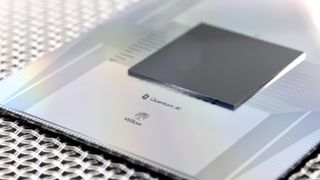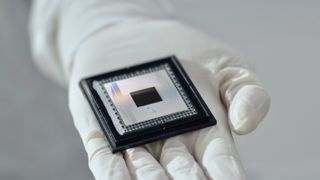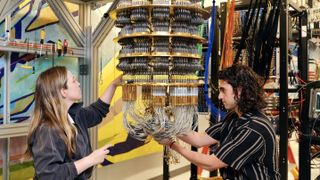
Google scientists have created a new quantum processor that, in five minutes, cracked a problem that would have taken the world's best supercomputer 10 septillion years to solve. The breakthrough will allow quantum computers to become less error-prone the bigger they get, achieving a milestone that overcomes a decades-long obstacle.
Quantum computers are inherently "noisy," meaning that, without error-correction technologies, every one in 1,000 qubits — the fundamental building blocks of a quan computer — fails.
It also means coherence times (how long the qubits can remain in a superposition so they can process calculations in parallel) remain short. By contrast, every one in 1 billion billion bits fails in conventional computers.
This high error rate is one of the key barriers to scaling up these machines so they are good enough to perform far better than the fastest supercomputers. This is why research has centered on building quantum computers with better and less error-prone — not simply more — qubits.
Google says its new quantum processing unit (QPU), dubbed "Willow," is the first in the world to achieve results that are "below threshold" — a milestone outlined by computer scientist Peter Shor in a 1995 paper. The team outlined the technology in a study published Dec. 9 in the journal Nature.
Cracking a problem set decades ago

The breakthrough — achieving this "below threshold" milestone — means that errors in a quantum computer will reduce exponentially as you add more physical qubits. It charts a path for scaling up quantum machines in the future.
The technology relies on logical qubits. This is a qubit encoded using a collection of physical qubits in a lattice formation. All the physical qubits in a single logical qubit share the same data, meaning if any qubits fail, calculations continue because the information can still be found within the logical qubit.
The Google scientists built sufficiently reliable qubits for exponential error reduction by making several shifts. They improved calibration protocols, improved machine learning techniques to identify errors, and improved device fabrication methods. Most importantly, they improved coherence times while retaining the ability to tune physical qubits to get the best performance.
Related: Monster 4,400-qubit quantum processor is '25,000 times faster' than its predecessor
"What we've been able to do in quantum error correction is a really important milestone — for the scientific community and for the future of quantum computing — which is [to] show that we can make a system that operates below the quantum error correction threshold," Julian Kelly, Google Quantum AI's director of quantum hardware, told Live Science.
This challenging task requires removing more errors from a system than are introduced. Below this threshold, scientists can scale up a quantum computer to be larger and larger, and errors will continue to decline, Kelly explained.
"This has been an outstanding challenge for 30 years — since the idea of quantum error correction was conceived of in the mid-90s," Kelly said.
Mind-boggling results for quantum computing
The Google researchers tested Willow against the random circuit sampling (RCS) benchmark, which is now a standard metric for assessing quantum computing chips. In these tests, Willow performed a computation in under five minutes that would have taken today's fastest supercomputers 10 septillion years. This is close to a quadrillion times longer than the age of the universe.
The first edition of the Willow QPU can also achieve a coherence time of nearly 100 microseconds — which is five times better than the showing from Google's previous Sycamore chip.
Google first announced that Sycamore had passed the RCS benchmark in 2019, when scientists used the chip to resolve a problem that would have taken a classical supercomputer 10,000 years to calculate. In July, a new quantum computer built by Quantinuum broke that record by 100 times.

Then, in October, Google again announced that it had discovered a new "quantum phase" when using Sycamore to process calculations, meaning the best QPUs today can outperform the fastest supercomputers in practical applications for the first time.
"Coherence times are now much higher than they used to be, and we immediately translate into basically lowering all the physical operation error rates by about a factor of two," Kelly said.
"So all the underlying qubits just got better at everything they do by about a factor of two. If you look at the logical error rate between this new processor and Sycamore, there's about a factor of 20 difference — and that comes from scaling up but also pushing below threshold."
Looking beyond "below threshold"
Google scientists are now aiming to demonstrate useful and practical computations for today's quantum chips, rather than relying on benchmarking.
In the past, the team has performed simulations of quantum systems that have led to scientific discoveries and breakthroughs, Kelly told Live Science.

One example includes discovering deviations from the assumed laws of physics. But these results were still within reach of the most powerful classical computers.
Next, the team wants to create a "very, very good logical qubit" with an error rate of one in 1 million. To build this, they would need to stitch together 1,457 physical qubits, they said.
This realm is challenging because it's impossible to get there using just physical hardware — you would need error-correction technology layered on top. The scientists then want to connect logical qubits together to perform better than supercomputers in benchmarking as well as real-world scenarios.


评论(0)